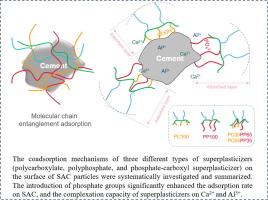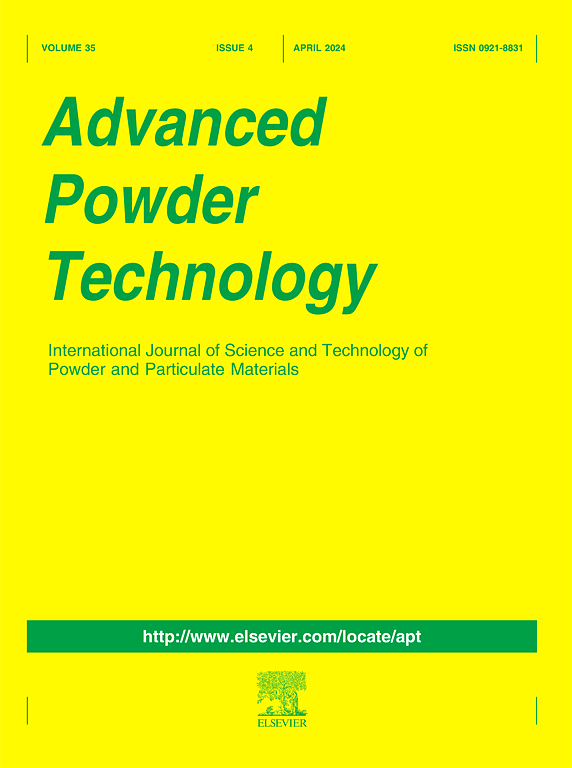高效减水剂中磷酸和羧基在硫铝酸盐水泥颗粒上的共吸附行为
IF 4.2
2区 工程技术
Q2 ENGINEERING, CHEMICAL
引用次数: 0
摘要
传统的高效减水剂一般适用于硅酸盐水泥,但不适用于硫铝酸盐水泥。本研究以丙烯酸(AA)、2-甲基丙烯酰氧乙基磷酸(MOEP)和异丁烯聚乙二醇(HPEG)为单体,合成了SAC专用的羧基与磷酸盐比例不同的高效减水剂。测试了含高效减水剂SAC浆料的初始流动性和流动性保持率,并评价了高效减水剂的磷酸基和羧基在SAC颗粒上的共吸附行为。结果表明,PC35PP65和PC65PP35具有更高的SAC浆料流动性,更大的吸附容量(分别是PC100的2.74倍和5.17倍),更高的吸附结合能,与Ca2+和Al3+的络合作用更强。吸附层厚度和流体动力半径(Rh)随磷酸基取代量的增加而增大。引入Langmuir、Freundlich和Temkin吸附模型和动力学拟合以及络合指数,阐明了SAC表面羧基和磷酸基的共吸附机理和协同吸附。本研究旨在揭示高效减水剂中磷酸、羧基在SAC颗粒上的共吸附行为及其协同作用,为SAC高效减水剂的进一步研究提供指导。本文章由计算机程序翻译,如有差异,请以英文原文为准。

Coadsorption behavior of phosphate and carboxyl groups in superplasticizer on sulfoaluminate cement particles
Conventional superplasticizers are generally applicable to Portland cement but not to sulfoaluminate cement (SAC). In this study, superplasticizers with different ratios of carboxyl to phosphate, which were used acrylic acid (AA), 2-methacryloyloxyethyl phosphate (MOEP), and isobutylene polyethylene glycol (HPEG) as monomers, were synthesized dedicated to SAC. The initial fluidity and fluidity retention of SAC paste containing superplasticizer were tested, and the coadsorption behavior of phosphate and carboxyl groups of superplasticizer on SAC particles was also evaluated. The results showed that PC35PP65 and PC65PP35 exhibited higher fluidity of SAC paste, greater adsorption capacity (2.74 and 5.17 times greater than that of PC100, respectively), higher adsorption binding energy, and stronger complexation with Ca2+ and Al3+. The adsorbed layer thickness and hydrodynamic radius (Rh) increased with the increase in phosphate group substitution. Moreover, Langmuir, Freundlich, and Temkin adsorption models and kinetic fitting, as well as complexing index, were introduced to clarify the coadsorption mechanism and the synergistic adsorption of carboxyl and phosphate groups on the SAC surface. The aim of this study is to reveal the coadsorption behavior of phosphate and carboxyl groups in superplasticizer on SAC particles and their synergistic effect, which can provide guidance for further research on SAC superplasticizers.
求助全文
通过发布文献求助,成功后即可免费获取论文全文。
去求助
来源期刊

Advanced Powder Technology
工程技术-工程:化工
CiteScore
9.50
自引率
7.70%
发文量
424
审稿时长
55 days
期刊介绍:
The aim of Advanced Powder Technology is to meet the demand for an international journal that integrates all aspects of science and technology research on powder and particulate materials. The journal fulfills this purpose by publishing original research papers, rapid communications, reviews, and translated articles by prominent researchers worldwide.
The editorial work of Advanced Powder Technology, which was founded as the International Journal of the Society of Powder Technology, Japan, is now shared by distinguished board members, who operate in a unique framework designed to respond to the increasing global demand for articles on not only powder and particles, but also on various materials produced from them.
Advanced Powder Technology covers various areas, but a discussion of powder and particles is required in articles. Topics include: Production of powder and particulate materials in gases and liquids(nanoparticles, fine ceramics, pharmaceuticals, novel functional materials, etc.); Aerosol and colloidal processing; Powder and particle characterization; Dynamics and phenomena; Calculation and simulation (CFD, DEM, Monte Carlo method, population balance, etc.); Measurement and control of powder processes; Particle modification; Comminution; Powder handling and operations (storage, transport, granulation, separation, fluidization, etc.)
 求助内容:
求助内容: 应助结果提醒方式:
应助结果提醒方式:


